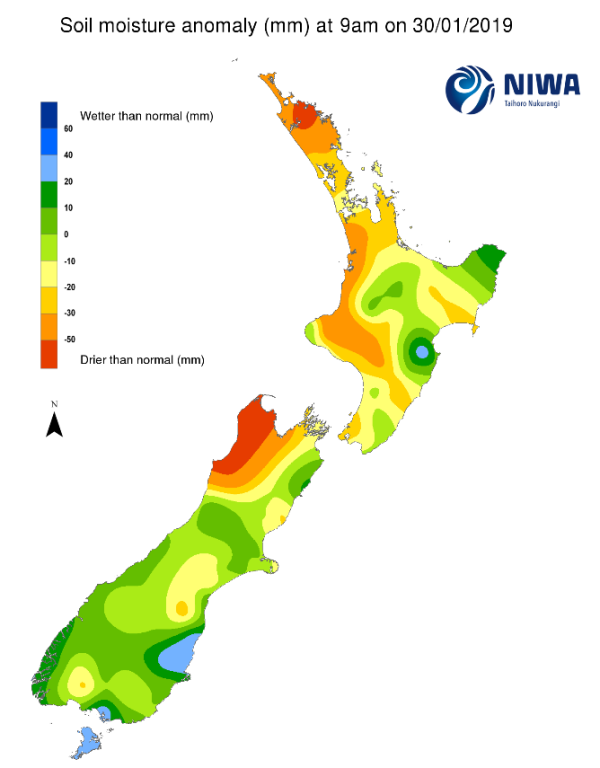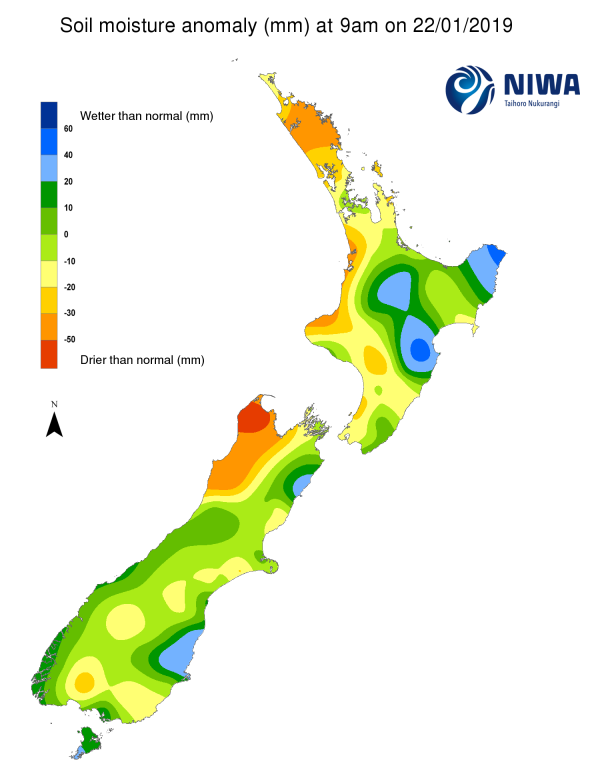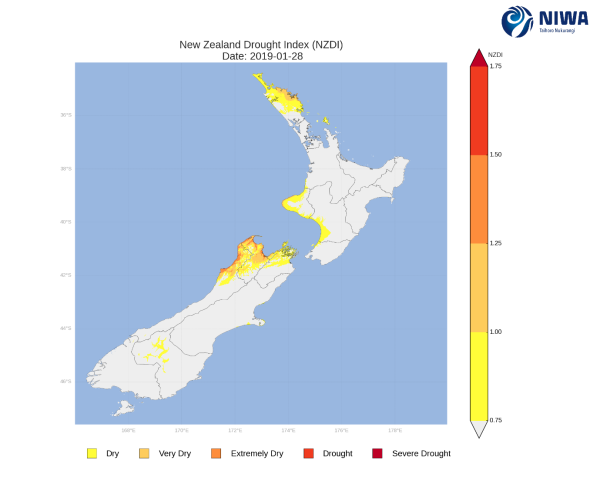A weekly update describing soil moisture across the country to help assess whether severely to extremely dry conditions are occurring or imminent. Regions experiencing these soil moisture deficits are deemed “hotspots”. Persistent hotspot regions have the potential to develop into drought.
Facts: Soil Moisture
Across the North Island, soil moisture levels decreased everywhere during the past week due to meagre rainfall and extremely warm temperatures. The most significant decreases were observed across the northern two-thirds of the island, with less substantial changes having occurred in the lower North Island. The driest soils across the North Island compared to normal for this time of the year are found in the Far North, while the wettest soils for this time of the year are located in a portion of Hastings District.
Areas deemed hotspots have expanded significantly during the past week in the North Island. A large hotspot now encompasses all of Northland and northern Auckland. Another large hotspot covers much of northern Waikato along with the Coromandel Peninsula. Additional hotspots are also in place in central Manawatu-Whanganui, Wellington City and Porirua, Mahia Peninsula, and a small portion of Tararua District.
Across the South Island, soil moisture levels generally decreased in northern areas, although small improvements were observed in interior Otago, Southland, and Stewart Island. The driest soils across the South Island compared to normal for this time of the year are found in western Tasman and northern Buller District, while the wettest soils for this time of the year are found in north coastal Otago, near Invercargill, and Stewart Island.
The previous hotspot encompassing Nelson and nearby portions of Tasman has continued to strengthen during the past week. In addition, a couple of new, small hotspots have begun to emerge in northern Hurunui District and interior South Canterbury.
Outlook and Soil Moisture
In the North Island, below to well below normal rainfall is expected during the next week. On Friday night and Saturday (2nd February), a decaying front will move north, bringing no more than 2-3 mm of rainfall to most locations. On Sunday, an easterly flow may deliver 5 mm or less to portions of Northland and Auckland. High pressure will bring dry weather on Monday and Tuesday (4th-5th February), with a few isolated showers possible on Wednesday.
Total weekly rainfall will likely be below 15 mm in eastern and southern portions of the North Island, and less than 10 mm in the upper North Island. This will likely lead to an expansion of all current hotspots, including across all of Auckland, more of Manawatu-Whanganui, and a larger portion of Wairarapa.
Moderate rainfall will move up the West Coast on Friday, bringing up to 40 mm in places. Meanwhile, the upper West Coast, Tasman, and lower South Island will receive less than 15 mm from the same event. High pressure will then bring dry weather from Saturday through to Monday (2nd-4th February). Another weaker front on Tuesday will bring up to 20 mm on the West Coast and less than 10 mm farther east. Total weekly rainfall will be up to 75 mm on the West Coast, 25 mm or less in the lower South Island, and generally less than 10 mm in the upper South Island.
Due to the expected rainfall, the current hotspot in Nelson and nearby Tasman will likely intensify and expand even farther in the next week. The new hotspot in Hurunui will likely strengthen as well, although the one in interior South Canterbury may remain almost unchanged.
Background:
Hotspot Watch a weekly advisory service for New Zealand media. It provides soil moisture and precipitation measurements around the country to help assess whether extremely dry conditions are imminent.
Soil moisture deficit: the amount of water needed to bring the soil moisture content back to field capacity, which is the maximum amount of water the soil can hold.
Soil moisture anomaly: the difference between the historical normal soil moisture deficit (or surplus) for a given time of year and actual soil moisture deficits.
Definitions: “Extremely” and “severely” dry soils are based on a combination of the current soil moisture status and the difference from normal soil moisture (see soil moisture maps for more information)



